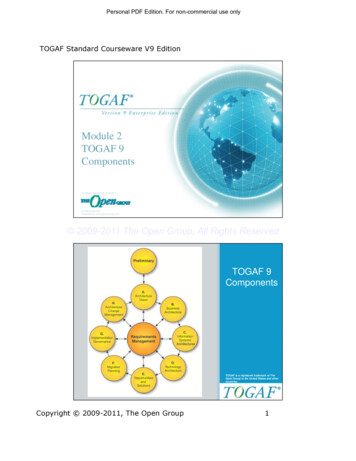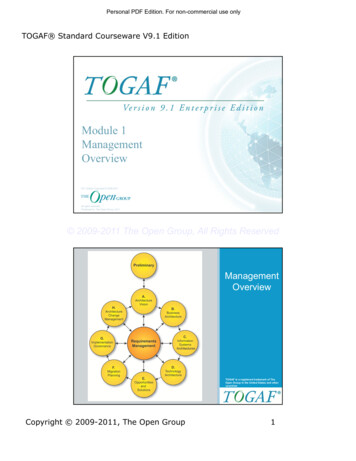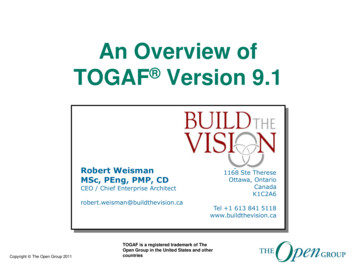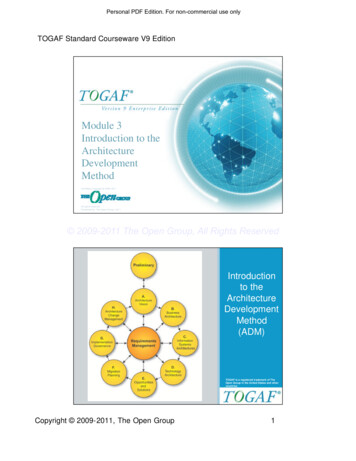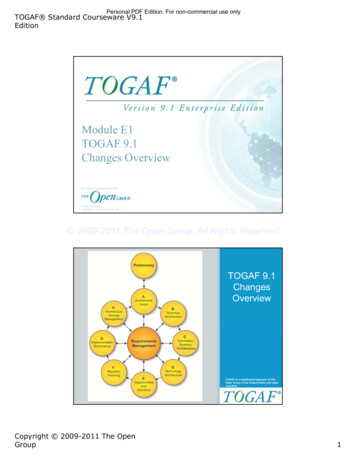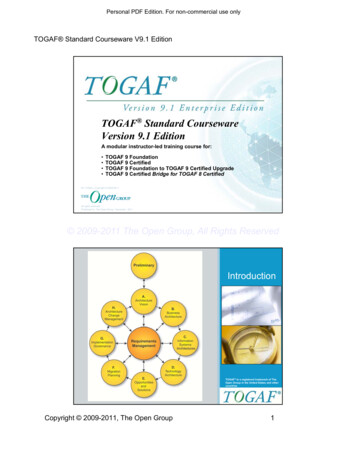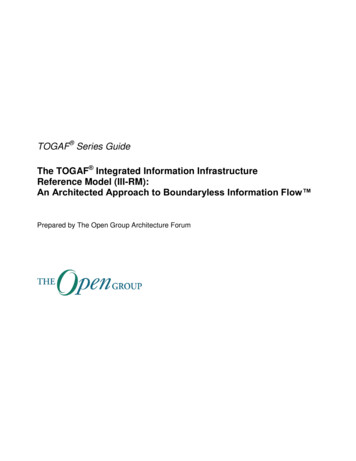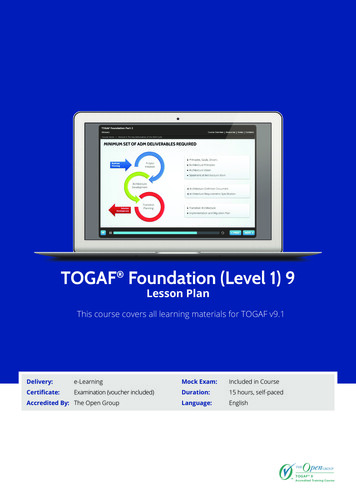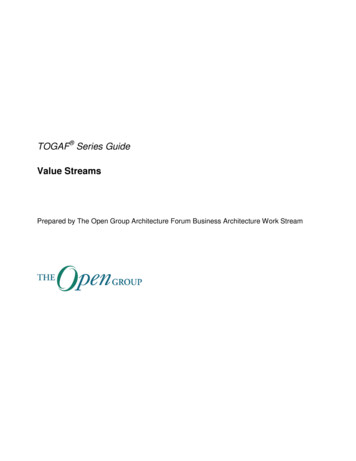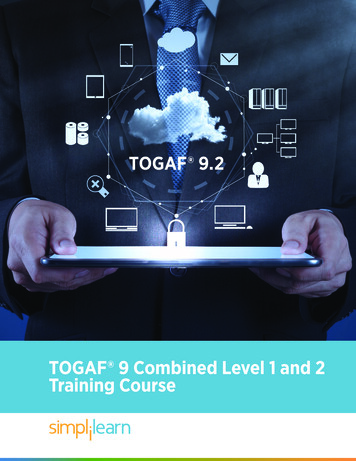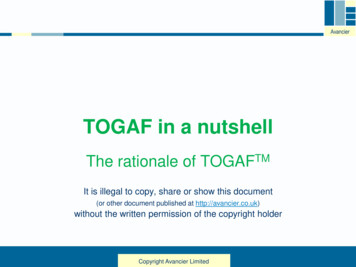
Transcription
AvancierTOGAF in a nutshellThe rationale of TOGAFTMIt is illegal to copy, share or show this document(or other document published at http://avancier.co.uk)without the written permission of the copyright holderCopyright Avancier Limited
TOGAFTM in a nutshell – the intention“The purpose of enterprisearchitecture is to optimize across theenterprise the often fragmented legacyof processes (both manualand automated) into an integratedenvironment ”An idea TOGAF takesfrom “EA as Strategy” byMIT authorsAvancier“TOGAF is intended to be a framework for “conducting enterprise architecture.” “managing the spectrum of changerequired to transform an enterprisetowards a target operating model” [defined by] the necessary level of business process integration and business process standardization.”“Operating model” for core businessprocessesHigh integrationCoordinatedUnifiedLow tion standardisationCopyright Avancier Limited
EA ends and meansAvancier To improve business systems, improve business data quality, relevance and use. To optimise business systems and increase agility tidy up the mess of duplicated and overlappingsystems by standardisation and integration.“Operating model”Integrated To help understanding and change impact analysis maintain an abstract description of business roles andprocesses and the systems they use To minimise business risks and maximiseopportunities keep an eye on information system & technologyevolution, and produce road maps where neededCopyright Avancier dardised““the EA is permanentand manages the EAartefacts delivered byprojects.” TOGAF
EA domainsAvancier EA is about the efficient & effective use of digitalinformation systems by business roles &processes “the effective management & exploitationof information through IT” TOGAF The EA is an abstract description of business roles& processes & the information systems &technologies they use.““the EA is permanentand manages the EAartefacts delivered byprojects.” TOGAFCopyright Avancier echnologies
ADM – the core process, the essence of TOGAFInitiate “a framework for managing the spectrum ofchange required totransform an ncePlan from a baselinearchitecture to atarget portunitiesAnd hnologyComponentsArchitecture definition docCopyright Avancier Limited
The Architecture Definition Document (ADD) You need an ADD to comply withthe overriding mission statement ofThe Open Group to produce Vendor-neutral specifications. Portable specificationsAvancierArchitecture definition documentDescriptive artefacts identifyarchitecture building blocks and howthey are relatedBusinessServices So stakeholders can sign off avendor/technology-neutralarchitecture specification.BISServicesC Artefacts in the ADD populate the “Architecture Continuum” “Architecture Repository”Copyright Avancier ponents
Architecture building blocks are “logical” An abstract specification of anenterprise /system that is Sufficient to describe the essenceof the business and its rules But sufficiently abstract – orlogical - to be portable Composed of ArchitectureBuilding Blocks which “describethe functionality without thedetail introduced by configurationor detailed design.”AvancierArchitecture definition documentDescriptive artefacts identifyarchitecture building blocks and howthey are related The basis of the “enterprisearchitecture” to be maintainedand governed after solutionshave been implemented.Copyright Avancier eBuildingBlockDTechnologyComponents
Solution building blocks are “physical”ERoad : “The first phase concerned with how the Target Architecture will beimplemented.”“[Identifies] SBBs which could address gaps and their associated ABBs.”“Physical elements in an EA may still be considerably abstracted fromSolution Architecture, design, or implementation views.”“Changes to the ABBs and interfaces will require architecture co-operation.”“Changes to the SBBs are not a major issue as long as the interfaces andbusiness rules are respected, and the SBB is made available across theorganization.”ArchitectureContracts“ensure conformance by implementation projects with the defined architecture”“Gaps in the existing enterprise solutions framework need to be identified and thespecific SBBs required to fill these gaps will be the identified by the ts“For maintenance changes - the outputs are Architecture updates”“The solutions or their operational context may change, while the architecturespecifications may not change”Copyright Avancier Limited
Who is TOGAF for?Avancier "In all cases, it is expected that thearchitect will adapt and build on theTOGAF framework in order to define atailored method that is integrated intothe processes and organizationstructures of the enterprise.“TOGAF 9.1 TOGAF can be, often is, tailored forsolution architecture projects. But does not give solution architects allthey need. And the ADM was written withstrategic cross-organisational EA inmindCopyright Avancier LimitedThis figure copyrightOpen Group
TOGAFTM in a nutshell – is strategic and cross-organisational “Much of the battle in the Preliminary Phase and Phase A is to establishthe EA team as having board-level, strategic and cross-organisational authority, to put in place the top-down command and control structure needed for cross-organisational EA to be successful.”Chapter 1 ‘‘horizontal - against the grain of normal vertical corporategovernance.”Chapter 32In other words, TOGAF is for EA, andEA is for strategic and cross-organisational changeCopyright Avancier LimitedAvancier
Remember TOGAF was initially written for EAAvancier If you view TOGAF only as a project or change managementframework for solution or infrastructure architects, you don’treally get the intention, because:“TOGAF is intended to be a framework for “conducting enterprise architecture.” “managing the spectrum of changerequired to transform an enterprisetowards a target operating model”“operating model” of core business plicatedStandardisedCopyright Avancier Limited
TOGAF expects enterprise architects to1.2.3.4.5.6.7.8.9.“optimize across the enterprise the oftenfragmented legacy of processes (both manualand automated) into an integratedenvironment ”“EA regards the enterprise as a system orsystem of systems.”“The architecture crosses multiple systems,and multiple functional groups within theenterprise.”“EA structures the business planning into anintegrated framework ”“ that is responsive to change and supportiveof the delivery of the business strategy.”“a structuring of Architecture Building Blocks(ABBs) which are reusable architectureassets.”“Architecture assets are applicable acrossthe entire scope of the EA.”“Subsequent executions will be easier, as moreand more architecture assets populate theorganization’s Architecture Repository.”“a procurement specification that [enables]open systems”Avancier1. Tidy up the mess of point solutions inthe enterprise2. Treat the whole enterprise as a system3. Build a cross-organisational picture ofthe enterprise4. Integrate the enterprise5. Enable business agility6. Facilitate reuse7. Reuse assets across the enterprise8. Use successive architecturedevelopment cycles to populate the[abstract] architecture repository9. With portable vendor/technology neutralspecificationsCopyright Avancier Limited
EA is expected to – maintain a repository1.2.3.4.5.6.7.8.AvancierTidy up the mess of point solutions in the enterpriseTreat the whole enterprise as a systemBuild a cross-organisational picture of the enterpriseIntegrate the enterprise““the EA is permanent andEnable business agilitymanages the EA artefactsdelivered by projects.”Facilitate reuseTOGAFReuse assets across the enterpriseUse successive architecture development cycles to populatethe [abstract] architecture repository9. With portable vendor/technology neutral specificationsCopyright Avancier Limited
EA is expected to - integrate and increase agility1.2.3.4.5.6.7.8.AvancierTidy up the mess of point solutions in the enterpriseTreat the whole enterprise as a systemBuild a cross-organisational picture of the enterprise“operating model”Integrate the enterpriseIntegrated CoordinatedUnifiedEnable business agilityDiversifiedReplicatedFacilitate reuseStandardisedReuse assets across the enterpriseUse successive architecture development cycles to populate the[abstract] architecture repository9. With portable vendor/technology neutral specificationsCopyright Avancier Limited
Let’s go back, way backAvancier TOGAF reflects the philosophy of TOGCopyright Avancier Limited
1993-1996: the formation of The Open Group An end to the Unix wars In 1993, Novell transfered the UNIX trademarkand certification rights to the X/Open Consortium. In 1996, X/Open merged with Open SoftwareFoundation, creating the Open Group. Open Group standards now define what is a Unix operating systems qualified to use the UNIX trademark.Copyright Avancier LimitedAvancier
The service-oriented philosophy of POSIX & UNIX standards Starting in 1998, the Open Group and IEEE started the AustinGroup, to provide a common definition of POSIX and the SingleUNIX Specification.External logicPOSIX.1 describes an operating system by its externalbehavior- as an interface to services (in C lsource code)- without regard to internal components or structureInternalPOSIX-compliant operating systems can, internally,implementation implement the same interface specification in whatevermanner is appropriate.Copyright Avancier LimitedAvancier
The philosophy of the Open Group is Open standards Public domainBacked by industry Like the POSIX and UNIX standards Service-oriented Vendor and technology-neutral With the idea that systems should be Interoperable PortableCopyright Avancier LimitedAvancier
Pressure to define an IT architecture framework The Clinger Cohen act dictated how every US federal government agency should reform itsIT management established in law that the CIO of a federal agency is responsible fordeveloping, maintaining and facilitating the implementation of asound and integrated IT architecture. This and other drivers put pressure on enterprises to tidy up their messy IT estate, rationalise the “building blocks” that provide IT services document them in a vendor-neutral wayCopyright Avancier LimitedAvancier
Vendor-neutral technology specification USA federal government guidance advised agencies to have Standards A Technical Reference model (TRM)External logicA TRM describes an enterprise’s infrastructuretechnologies by their external behavior- the platform services they provide- without regard to their implementation by any specificvendor or technologyInternalTRM-compliant technologies can implement the TRM inimplementation whatever manner is appropriate to the enterprise By following the service-oriented philosophy of The Open Group A TRM assists in vendor-neutral technology procurementCopyright Avancier LimitedAvancier
So, TOGAF was built around a service-oriented TRM TOGAF (v 1 to 7) was primarily about describing the IT servicesa business needs - at a more abstract level than source code - inportable and interoperable IT services specification.DoDTRMArmedForcesTAFIMPOSIXTOGAFv1 1995 Then using that specification to tidy up a messy IT estate, rationalise the “building blocks” that provide IT services document and procure them in a vendor-neutral wayCopyright Avancier LimitedAvancier
2002, TOGAF 8 embraced business architectureAvancier Adopted IE-style "structured analysis” for business architectureArmedForcesPOSIXDoDTRMTAFIMJTA StandardsDoDAF 12004For acquisitionOf info systemsTOGAFv1 1995TOGAFv7 2001DoDAFv2TOGAFv8 2003TOGAFv9.1 2011SAPEAFInformationEngineering TOGAF takes a holistic view IT systems exist to provide information services to businesses A business exists to provide business services to external entitiesCopyright Avancier Limited
TOGAF’s view of Business Architecture The businessarchitecture is theprimary architecture. But the focus is onbusiness roles andprocesses supportedby IS (rather than on humannature, managementculture or organisationdesign)AvancierBusiness - roles and processes supported by ISInformationSystems - digitised business apps and dataTechnology - infrastructure platform for business appsCopyright Avancier Limited
TOGAF’s 3 architecture domains and 6 essential entities This 3-layer view iscommonplace ormServicesTechnologyComponentTechnologyCopyright Avancier yComponent
Today, TOGAF is centered on the business app portfolio Business apps are at the heart of the TOGAF meta model IT technology / infrastructure / operations are addressed only lightly As word counts itecture5,589Business2,059Capability501View1,836IT (embraces IS)498Data Information1,704Interop integrat471Model1,408User354Application (business)1,389Actor348Strateg266System (mostly business app)1,357Design262Service1,162Technical215Process (mostly business)1,098Customer142Business hnol .673Function (mostly business)663OperatorEnterprise arc 81Platform44Developer40Solution arc 14Copyright Avancier Limited6
The context and underlying rationale The Open Group is “a vendor-neutral and technology-neutral consortium,whose vision of Boundaryless Information Flow Next slidewill enable access to integrated information,within and among enterprises, based on open standards and global interoperability.”Hence, TOGAF aims to help enterprises avoid or overcome:1. Vendor and/or technology-dependence2. Data locked in inaccessible silos3. Data disintegrity4. Applications that cannot share data5. Applications that cannot be ported between technology environments.Copyright Avancier LimitedAvancier
The Boundaryless Information FlowTM “1. A trademark of The Open Group.AvancierA banner to followA vision rather than a plan. 2. A shorthand representation of ‘‘access tointegrated information to support business processimprovements’’ representing a desired state of an enterprise’sinfrastructure specific to the business needs of theorganization. An infrastructure that provides BoundarylessInformation Flow has open standard componentsthat provide services in a customer’s extendedenterprise that: Combine multiple sources of infor mation Securely deliver the information whenever andwherever it is needed, in the right context for thepeople or systems using that information.”Copyright Avancier Limited
The Boundaryless Information FlowTM More memorable as the US Air Force concept of "A5 Interoperability“ The required data is available Any time,Any where, and inAny way, byAny one, who isAuthorizedCopyright Avancier LimitedAvancier
TOGAFTM in a nutshell – the intention“The purpose of enterprisearchitecture is to optimize across theenterprise the often fragmented legacyof processes (both manualand automated) into an integratedenvironment ”An idea TOGAF takesfrom “EA as Strategy” byMIT authorsAvancier“TOGAF is intended to be a framework for “conducting enterprise architecture.” “managing the spectrum of changerequired to transform an enterprisetowards a target operating model” [defined by] the necessary level of business process integration and business process standardization.”“Operating model” for core businessprocessesHigh integrationCoordinatedUnifiedLow tion standardisationCopyright Avancier Limited
FootnotesAvancier There is much more explanation of TOGAF at avancier.co.uk And the TOGAF tutor’s dilemma follows here Copyright Avancier Limited
TOGAF is a management framework for EA A challenge for EA Can you get enough business management engagementto do EA, and so use TOGAF as intended? A challenge for SA Does TOGAF give solution architects what they want? "As an open framework, [selective] use is encouraged. In all cases, it is expected that the architect will adaptand build on the TOGAF framework in order to define atailored method that is integrated into the processesand organization structures of the enterprise.“TOGAF 9.1Copyright Avancier LimitedAvancier
Ad hoc use of TOGAF is fine Elements of TOGAF are in used solution architecture business analysis even technical architecture. But a method written for cross-organisational and strategic EAcannot provide everything a solution architect wants. Moreover, TOGAF cannot definitively link EA to Business Planning PMO SDLC ITSMTOGAF has no ideawhat methods youare using for those.Copyright Avancier LimitedAvancier
"four management frameworks.have to work closely together.”YOU have to makethem work together Business Planning conceives, directs, and provides the resources for all activitiesrequired to achieve concrete business objectives/outcomes. Enterprise Architecture [EA] structures and gives context to activities delivering concrete businessoutcomes, primarily but not exclusively in the IT domain. Portfolio/Project Management [PMO] co-ordinates, designs, and builds the business systems that deliverthe concrete business outcomes. Operations Management [ITSM] integrates, operates, and maintains the deliverables that deliver theconcrete business.Copyright Avancier LimitedAvancier
Adapting TOGAF can take it away from EAAvancierConsultants, solution and technical architects commonly bend TOGAF to tactical solution architecture rather than for enterprise architecture use TOGAF in a selective and sketchy way rather than follow the ADM process steps are given SBBs to implement rather than define logical ABBs and then select best -fit physicalSBBs. do not populate the “Architecture Continuum” with logical,portable and reusable ABB specifications, or leave behindany persistent and maintainable EA““the EA is permanentand manages the EAartefacts delivered byprojects.” TOGAFCopyright Avancier Limited
So, the TOGAF tutor’s dilemma Should I teach TOGAF for cross-organisational EA, as it isintended? Or should I teach TOGAF as a generic management processyou can adapt for any large-scale change project that requiresarchitectural thinking and documentation?Copyright Avancier LimitedAvancier
Who is TOGAF for? "In all cases, it is expected that the architect will adapt and build on the TOGAF framework in order to define a tailored method that is integrated into the processes and organization structures of the enterprise.“ TOGAF 9.1 TOGAF can b
